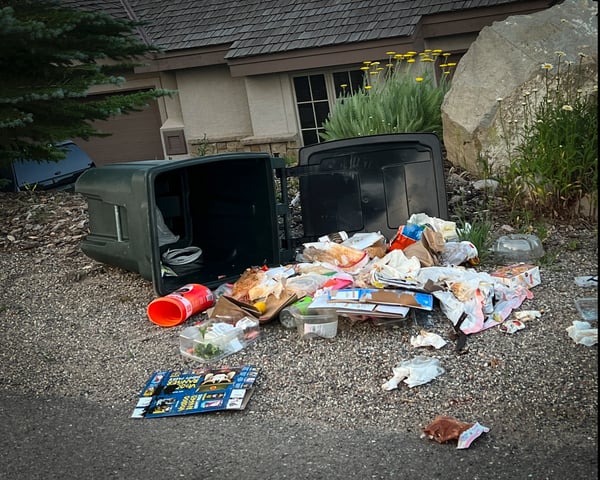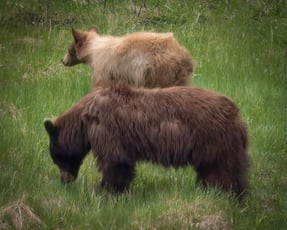This article is from the Eagle County Community Wildlife Roundtable.
text and Photographs by Rick Spitzer (except as noted.)
Are We the Problem?
Reports of bear sightings and human-bear conflicts have doubled from 2019 to this year in Eagle County. Why the problem and what can be done?
At the end of every summer, we approach a period where bears are getting ready for winter hibernation and enter a phase called hyperphagia. They become exceptionally hungry and will eat just about anything that doesn’t eat them first.
When the berry crop is reduced by late frosts or drought conditions berries may not meet the needs of a bear before hibernation.
What do bears eat in the wild? Any high-quality food items that have a high nutritive value and a low foraging effort are on the menu. How much do they prowl for food on a daily basis? 20+ hours! How many calories do they need? 20,000!!
A photo with this article shows what 20,000 calories worth of food looks like, according to Colorado Parks and Wildlife (CPW). All that every day!
A coffee cup full of blueberries is 57 calories, and a bear would need 350 cups of berries to get to 20,000 calories. How about carrion? A pound of mule deer meat has 712 calories. Mule Deer yield between 45 lbs to 55 lbs. of boneless meat, on average. The bear would need to consume 28 pounds of meat, a little more than one mule deer every two days.
Look around you as you hike. Can you even see 20,000 calories? It is amazing that there is that much food out there. Also think about a female bear with 2-3 cubs. She has to find food for them as well.
The availability of those food items on a bear’s menu is influenced by annual and seasonal variation in their natural foods. A black bear’s diet includes meat, fish, larvae, insects, and carrion. In addition, there are many plant sources for food including succulent plants, roots, grass, berries, fruits, and honey.
This year there was a late frost and as a result, CPW has indicated the natural food sources are not in plentiful supply. Research has shown when bears cannot find enough natural food sources, they travel to where food is more easily accessible. Because of this wide-ranging diet, bears have a lot of options when they find your house.

This is an all to common site when driving around the neighborhood on trash day. Photo: Alan Finney
They find your house, cars, and trashcans because of an incredible sense of smell. If trashcans are left outside and are accessible to bears, that's an easy meal. If there is pet food or even bird feeders outside within reach of a bear, that is another easy meal. If a window is left open or a door unlocked and there are good smells coming from inside, that's another temptation for bears. Once they find the options at your house or are taught to do that by their mother, things can get difficult for them and for you. We want to do everything possible to avoid these scenarios to keep you, your pets and bears safe.
Bears can become habituated due to a low foraging effort needed to obtain a lot of calories. When bears become habituated to finding an easy meal at homes, businesses, or in cars, it is difficult to change their behavior.
Some might think a bear can just be relocated to solve the problem, however, translocations are not always effective. The translocated bears may find the same food source in their new area, transferring the problem to someone else. In some cases, bears have traveled hundreds of miles and end up making their way back to the original neighborhood.
Translocation may also reduce the ability of the bear to survive. It may be introduced into an area that is already in use by other bears. In many cases the relocated bear is replaced by a different bear if the food sources are still there. There is a joke among wildlife managers “that the “relocated” bears beat the wildlife management trucks back to where that bear was captured.”
You do not want to leave your house and come upon a bear searching for some quick calories.
Lethal removal is not a management tool that CPW officers want to apply to these situations. If an animal becomes dangerous to people, it may be the only option. CPW officers want to focus on improving healthy, safe habitats and removing animals is not their preferred option. It’s up to us to be responsible and prevent bears from becoming used to getting food where people live.
The majority of issues occur in the urban-wildland interface where reliable and high-calorie foods can be found by bears. That food may be in the form of garbage, fruit trees, vegetable gardens, pet food and bird feeders. Open compost piles containing kitchen scraps, are irresistible to bears. Reducing the availability of human foods for bears has a huge impact on reducing bear conflicts because they are likely to increase their use of natural foods.
What can we do?
People are the real problem, we need to take steps to keep bears out of our neighborhoods. Making human food sources unavailable is generally easy. Keep garbage in closed garages or buildings, only put trashcans out the morning of pick-up and bring them in that same day. Be careful not to over-fill trashcans and ensure the lid closes. A trash can that locks is even better. Consider the impact of fruit trees and vegetable gardens. Don’t leave pet foods outdoors. Take down bird feeders or don’t put them out during “bear season."
It is simple - reduce, remove and properly secure attractants.
That's the best way to reduce human-bear conflicts, it protects bears and us by separating the bears from the foods we produce so the bears look for natural foods in their environment.
.jpeg?width=500&height=400&name=BearAwareSticker01%20(1).jpeg)
We are lucky that we do not have to deal with grizzly bears. Grizzlies are powerful and can weigh up to 600 lbs. and be 3.3 ft. at Shoulder. They no longer exist in Colorado, but they do produce similar problems in Jackson, Wyoming.
Jackson came up with an effective solution. This approach is consistent with an evidence-based study CPW conducted in Durango where implementation of wildlife proof trashcans and compliance efforts resulted in a 50% reduction in human-bear conflict.
Jackson’s Town Council approved a new wildlife feeding code that will require residential and commercial bear-resistant trash containers or enclosures on the outer edges of town. The “Town Bear Conflict Zone” was established where data indicates most human-bear conflicts have occurred in the last ten years. The Teton County Board of County Commissioners also unanimously approved regulations that would require bear proof trash cans countywide. Bear resistant trash containers are now required in all of Teton County starting July 1, 2022
A non-profit along with Jackson Hole Bear Solutions seeks to remove barriers and improve access to bear-resistant trash cans. Under the program, special trashcans that block the scent of garbage and resist bears’ attempts to open them will be provided to any resident or business in Teton County, regardless of financial status, who requests one. With the help of grants and donations, residents will be able to afford these cans or can rent one through their trash hauler.
In Colorado our human-bear conflict problem is the same, except that we are dealing with black bears which are about half the size of grizzlies. Most Colorado communities that have issues with human-bear conflict have ordinances that have been structured to protect the black bear and the members of the community.
Most local bear and trash ordinances in Colorado towns and counties state that it is unlawful for any person to store refuse that is edible by wildlife other than in a Wildlife Proof Refuse Container or in other containers located within a building, house, garage, or Dumpster Enclosure.
In addition, persons with curbside refuse pickup service shall not place Refuse Containers, other than Wildlife Proof Refuse containers, at the curb for pickup. Times may vary, but they may not place them before 5:00 a.m. on the morning of their scheduled collection day. After pickup, Refuse Containers must be returned to the building, house, garage, or Dumpster Enclosure by 6:00 p.m.
Fines also vary across the state, but may have a first violation that starts at $100. Second violation can be up to $500 and a 3rd Violation can be $1000 and/or jail time. See your specific Town of County Ordinance for details.
We need your help to solve this problem! All we need to do is make food sources unavailable!
• Keep pet food and trash containers inside
• Put out the trash the morning of trash day, bring empty cans in the same day
• Keep doors and windows locked
• Don’t leave food in your car
• Take down bird feeders during bear season
It just might save a bear's life!
Colorado Parks and Wildlife has several resources on the web to make you more “Bear Aware.” They include Bearproofing Videos and other resources. Search Colorado Parks and Wildlife bear aware
======================================
The Eagle County Community Wildlife Roundtable is a collaborative partnership with the White River National Forest, Colorado Parks and Wildlife, Bureau of Land Management, local government entities, community members, and citizen scientists. The purpose of the Eagle County Community Wildlife Roundtable is to gather a group of diverse stakeholders in the valley to understand and address issues facing wildlife populations. Together we will identify a shared vision and realistic actions that the community can rally around to support wildlife. We want to leverage diverse values, creativity, and resources to move toward positive action.
======================================





.jpeg?width=500&height=400&name=BearAwareSticker01%20(1).jpeg)




